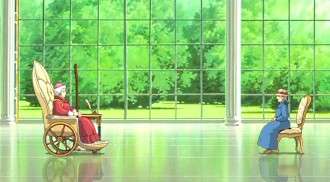Widescreen Shot
Widescreen films relying on wide Aspect Ratio shots to show themselves off. At first, these were largely landscape shots, but as they didn't give people headaches, they were a lot more successful, and an integral part of Scenery Porn in films.
Later on directors such as David Lean and Akira Kurosawa used the format for more artistic shots, to the point where their widescreen films actually lose a lot in being cropped to 4:3 ratio.
Although landscapes are still some of the most common forms of widescreen showing shots, others include people far apart from each other or showing a huge crowd of people.
One definite gimmick form of this is showing a shot in normal screen ratio, and then having it spread out to widescreen.
Film studios also marketed their respective widescreen formats in the early days (since they each used tech that could be patented), even if most were essentially the same result (a wider camera and screen), except for Cinerama (which utilized three synchronized projectors over three standard ratio screens).
Compare Letterbox, Visual Compression (both are ways to try to fit widescreen into normal ratio), 3D Movie, Shoot the Money.
Contrast Pan and Scan.
- The desert shots in Lawrence of Arabia
- One of the few memorable images in Pearl Harbor was the shot of the Japanese planes flying in from behind the camera.
- The Star Destroyer shot in A New Hope.
- Kurosawa was fond of shots of Samurai standing far apart from each other, and was referenced at the end of Kill Bill part 1.
- The final graveyard scene in The Good, the Bad and the Ugly.
- Harold Ramis jokes that when Ghostbusters is shown in a cropped version he's cut out of every group shot since the film can only fit all the actors standing in a row in widescreen.
- Lampshaded in the Classic Disney Short "Grand Canyonscope", where Ranger Woodlore encourages a crowd of visitors to the Grand Canyon to spread out because they're in Cinemascope.
- Will Success Spoil Rock Hunter has a brief intermission where the Cinemascope screen shrinks down to a tiny square, for those in the audience who are accustomed to watching television. The screen can scarcely show Tony Randall in full view, and he has to crouch down to get his head in the shot.
- The Girl Can't Help It had a similar opening trick.
- Several tournament shots in A Knight's Tale.
- 1956's Around the World in Eighty Days begins with a small, square introduction, matching the old footage of A Trip to the Moon used therein, and then the screen widens out dramatically to show off the 70mm format.
- Benny Hill did a sketch where a widescreen film was being shown on TV with the Pan and Scan being done as it was being broadcast, resulting in missing just about every action of note.
- Joss Whedon deliberately put several of these in the Firefly pilot, to force the studio to broadcast the show in widescreen format. The network's response was that they would broadcast the pilot (at the end of the series) in widescreen, so long as he never pulled this stunt again so they could air the rest of the series in 4:3. (A good example of how short-sighted the executives who cancelled the show were: less than a decade later, the series thrives exclusively on widescreen DVD, and all broadcasting is done in widescreen.)
- Well before widescreen was even a gleam in an inventor's eye, the 1973 Belmont Stakes managed to pull one of these off by pulling the camera as far back as humanly possible when Secretariat - who would go on to demolish the competition with a 31-length win - rounded the far turn and began roaring down the backstretch. In fact, race caller Chic Anderson originally called the race as a 25-length victory, and it took careful analysis of that very widescreen shot to confirm the actual numbers.
- Two Oscar-winning movie musicals that Robert Wise directed, West Side Story and The Sound of Music, begin with aerial pans across the landscape of the respective movie's setting (either Manhattan or Austria).
- Galaxy Quest has an interesting version of this. The opening shots of the film is footage from the (fictional) television series, and shown in a 4:3 aspect ratio. Then the first quarter or so of the movie is the flat aspect ratio (1.85:1), before opening up the the scope ratio of 2.35:1 on a sprawling space vista.
- The same thing is done in The Horse Whisperer, with the widescreen not being used until the film gets to Montana to make the landscapes even more impressive.
